Davis Strait
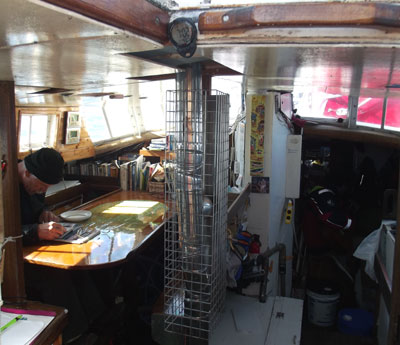 The view in the pilothouse. To the left, Lin is studying the Greenland cruising guide, on the right, farther forward and much less visible, Jordan is playing his guitar.
The view in the pilothouse. To the left, Lin is studying the Greenland cruising guide, on the right, farther forward and much less visible, Jordan is playing his guitar.
Monthly Archives: July 2011
A Beautiful Day in Davis Strait
Davis Strait
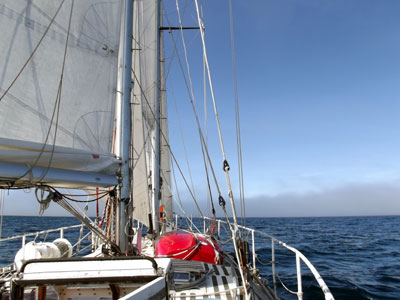 A beautiful day sailing in the Davis Strait. We sailed in and out of fog banks, which can be seen ahead of the boat in the picture. Davis Strait was named for John Davis, the English mariner of the 1500s. Davis Strait is north of the Labrador Sea, lying between Baffin Island and Greenland. Northwest of Davis Strait is Baffin Bay.
A beautiful day sailing in the Davis Strait. We sailed in and out of fog banks, which can be seen ahead of the boat in the picture. Davis Strait was named for John Davis, the English mariner of the 1500s. Davis Strait is north of the Labrador Sea, lying between Baffin Island and Greenland. Northwest of Davis Strait is Baffin Bay.
It Often Looks Like This
Labrador Sea
 We have been doing a lot of motoring in calm, foggy conditions. This is what we can typically see (pretty much nothing beyond 100m). The lights visible thru the window are, left to right, the VHF/AIS, radar and GPS.Thanks for the comments. At sea, I generally do receive the comments, but can’t reply in line. As to the location of the engine oil cooler, it sits between the engine block and the engine oil filter. As to what factors to consider when deciding where to land in Greenland, well, I’m still deciding :). I had indefinite plans of going first to Nuuk, and our course has been basically straight for Nuuk. Being the biggest city in Greenland, Nuuk is the obvious best choice for repairs and provisioning. At the moment, it looks like we will have moderate southerly winds for the next two days (we have no wind now), so, given what will be a good tailwind, and the expected boost we will have from the West Greenland Current, we may bypass Nuuk and make the first port someplace farther up the coast. —
We have been doing a lot of motoring in calm, foggy conditions. This is what we can typically see (pretty much nothing beyond 100m). The lights visible thru the window are, left to right, the VHF/AIS, radar and GPS.Thanks for the comments. At sea, I generally do receive the comments, but can’t reply in line. As to the location of the engine oil cooler, it sits between the engine block and the engine oil filter. As to what factors to consider when deciding where to land in Greenland, well, I’m still deciding :). I had indefinite plans of going first to Nuuk, and our course has been basically straight for Nuuk. Being the biggest city in Greenland, Nuuk is the obvious best choice for repairs and provisioning. At the moment, it looks like we will have moderate southerly winds for the next two days (we have no wind now), so, given what will be a good tailwind, and the expected boost we will have from the West Greenland Current, we may bypass Nuuk and make the first port someplace farther up the coast. —
Its Not Always Like This
Labrador Sea
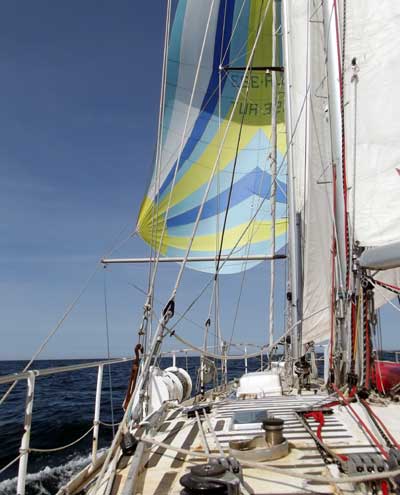 It’s not always like this in the Labrador Sea! Clear skies, light following winds, warm (if wearing thermal underwear) temperatures–very pleasant, and good conditions for taking pictures.
It’s not always like this in the Labrador Sea! Clear skies, light following winds, warm (if wearing thermal underwear) temperatures–very pleasant, and good conditions for taking pictures.
Away Again
Labrador Sea
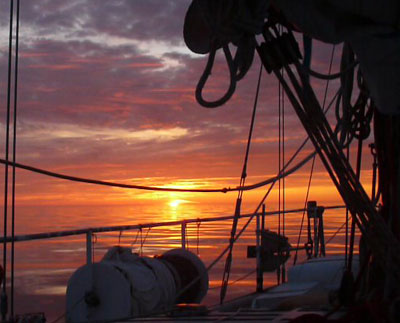 The day after getting the engine fixed, we picked up groceries, filled the water tanks and sailed off. The wind was perfect for sailing off the dock (instead of motoring off), so we cast off the lines and set the sails and sailed off. We sailed away from the docks then beat our way out the entrance channel, tacking (turning the boat thru the wind so the sails go to the other side) every 3-5 minutes. The current was in our favor, which was good, as the tacks were not easy to do. Tacking the yankee jib was more difficult than before because instead of dragging the sail and sheets (ropes) across the smooth surface of the aluminium extrusion of the roller furler of the staysail/trinquette, it now dragged across a wire stay, so tended to get stuck. I can’t think of any port in the Labrador Sea where I’d like to try getting furler parts, so we will live with it as it is–it is an inconvenience, not a major problem. We had a crew change in Cartwright. Ryan got off the boat and Lin, a merchant marine officer, came aboard.
The day after getting the engine fixed, we picked up groceries, filled the water tanks and sailed off. The wind was perfect for sailing off the dock (instead of motoring off), so we cast off the lines and set the sails and sailed off. We sailed away from the docks then beat our way out the entrance channel, tacking (turning the boat thru the wind so the sails go to the other side) every 3-5 minutes. The current was in our favor, which was good, as the tacks were not easy to do. Tacking the yankee jib was more difficult than before because instead of dragging the sail and sheets (ropes) across the smooth surface of the aluminium extrusion of the roller furler of the staysail/trinquette, it now dragged across a wire stay, so tended to get stuck. I can’t think of any port in the Labrador Sea where I’d like to try getting furler parts, so we will live with it as it is–it is an inconvenience, not a major problem. We had a crew change in Cartwright. Ryan got off the boat and Lin, a merchant marine officer, came aboard.
The John Deere Saga
Cartwright, Labrador, Canada
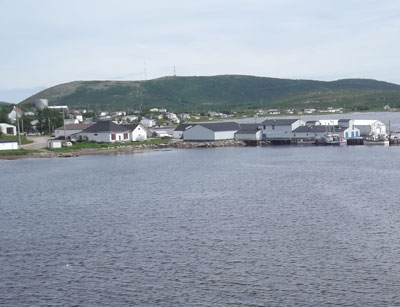 (Long, technical) Two weeks ago, as we sailed into Cartwright Harbor (pictured). A few hundred metres away from the dock, we started lowering sails and prepared to start the engine to motor onto the dock. The engine oil level was unexpectedly high. The oil was black, so I figured the fuel pump had leaked fuel into the crankcase, as I saw no signs of water. We started the engine and motored onto the dock.After shutting down the motor, the oil was checked again, and now it looked like a chocolate milkshake, a sure indication that water was mixed into the oil. The oil was changed and the filter washed out with fuel. I’d bought a dozen “compatible” oil filters at the auto parts store in Rimouski a month ago and hadn’t used any of them yet, so hadn’t yet realized that none of thembe fit the engine. So, I needed to find the source of the water getting into the fuel and change the oil and filter enough times to clear all the water out (when water mixed with antifreeze mixes with the oil, the antifreeze prevents the oil from lubricating the bearings and it soon destroys the engine if the engine is continued to be run). No suitable oil filters were available in Cartwright.The engine in Issuma is made by John Deere, but marinized (mostly this means adding a heat exchanger and a seawater pump so seawater cools the antifreeze/water that the engine is cooled with) by Baudouin. As Baudouin is in France, with only one dealer in Canada (in Montreal), versus John Deere being the real manufacturer of the engine and having many dealers all over the place, including Newfoundland, I figured they would be the best place to have a new oil cooler and head gasket (the two possible ways for the engine water/antifreeze to get into the oil) sent from. I called up the John Deere dealer from the payphone in the store (no cellular service here) and ordered the parts. The John Deere dealer needed the serial number of the engine to get the correct oil cooler. Unfortunately, when Baudouin marinized the engine, they REMOVED the serial number plate from the engine, putting their own serial number plate in its place. I had a service manual for the engine, which said there were three possible oil coolers, and had pictures of each type. I emailed a copy of the relevant page of the service manual to the John Deere dealer, and he thought he could get the right one based on that.The oil filters took six days to arrive, as the dealer thought they would be best shipped to Goose Bay by air and then transferred to something else to get to Cartwright. After a few days, everyone in Cartwright knew we were at the dock, waiting for parts, and people helped us out. Blair Gillis and Innu Mikkun airlines got the parts and put them on a charter flight that was going to Cartwright. Then I was able to change the oil and filter several times and determine that the problem was the oil cooler. The oil cooler, which had to be sent from Ontario, arrived after several more days. Unfortunately, it was not the same type as the old one, so didn’t fit. Knowing there was a machine shop in Goose Bay (a 5 hour drive), I hitchhiked to Goose Bay, got a part modified at the machine shop the next day, and hitchhiked back. Several more hours of installing the oil cooler and replacing hoses (they needed to change size to work with the new oil cooler) and the engine was running properly.
(Long, technical) Two weeks ago, as we sailed into Cartwright Harbor (pictured). A few hundred metres away from the dock, we started lowering sails and prepared to start the engine to motor onto the dock. The engine oil level was unexpectedly high. The oil was black, so I figured the fuel pump had leaked fuel into the crankcase, as I saw no signs of water. We started the engine and motored onto the dock.After shutting down the motor, the oil was checked again, and now it looked like a chocolate milkshake, a sure indication that water was mixed into the oil. The oil was changed and the filter washed out with fuel. I’d bought a dozen “compatible” oil filters at the auto parts store in Rimouski a month ago and hadn’t used any of them yet, so hadn’t yet realized that none of thembe fit the engine. So, I needed to find the source of the water getting into the fuel and change the oil and filter enough times to clear all the water out (when water mixed with antifreeze mixes with the oil, the antifreeze prevents the oil from lubricating the bearings and it soon destroys the engine if the engine is continued to be run). No suitable oil filters were available in Cartwright.The engine in Issuma is made by John Deere, but marinized (mostly this means adding a heat exchanger and a seawater pump so seawater cools the antifreeze/water that the engine is cooled with) by Baudouin. As Baudouin is in France, with only one dealer in Canada (in Montreal), versus John Deere being the real manufacturer of the engine and having many dealers all over the place, including Newfoundland, I figured they would be the best place to have a new oil cooler and head gasket (the two possible ways for the engine water/antifreeze to get into the oil) sent from. I called up the John Deere dealer from the payphone in the store (no cellular service here) and ordered the parts. The John Deere dealer needed the serial number of the engine to get the correct oil cooler. Unfortunately, when Baudouin marinized the engine, they REMOVED the serial number plate from the engine, putting their own serial number plate in its place. I had a service manual for the engine, which said there were three possible oil coolers, and had pictures of each type. I emailed a copy of the relevant page of the service manual to the John Deere dealer, and he thought he could get the right one based on that.The oil filters took six days to arrive, as the dealer thought they would be best shipped to Goose Bay by air and then transferred to something else to get to Cartwright. After a few days, everyone in Cartwright knew we were at the dock, waiting for parts, and people helped us out. Blair Gillis and Innu Mikkun airlines got the parts and put them on a charter flight that was going to Cartwright. Then I was able to change the oil and filter several times and determine that the problem was the oil cooler. The oil cooler, which had to be sent from Ontario, arrived after several more days. Unfortunately, it was not the same type as the old one, so didn’t fit. Knowing there was a machine shop in Goose Bay (a 5 hour drive), I hitchhiked to Goose Bay, got a part modified at the machine shop the next day, and hitchhiked back. Several more hours of installing the oil cooler and replacing hoses (they needed to change size to work with the new oil cooler) and the engine was running properly.
Stitching
Cartwright, Labrador, Canada
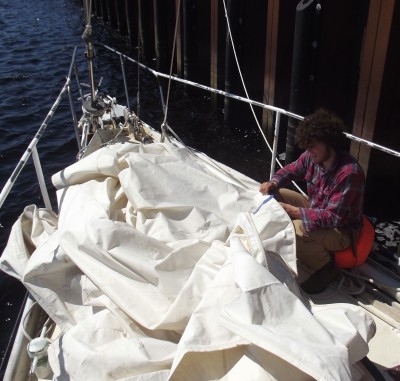 When the inner jib stay came down, part of the roller reefing broke. While I might be able to fix the roller reefing gear, I have one more of these units aboard controlling the yankee jib (outer jib), which I’m more interested in keeping spare parts for than I am in using for this sail. This sail, the inner jib (or trinquette or fore-staysail) rarely gets reefed–it is either set fully or furled (when it gets windy, I am using the storm jib). So I decided to convert it to a hanked-on sail.In the picture, Jordan is sewing webbing into the sail to hold shackles, which we are using as hanks (can’t buy hanks here) to attach the sail to the stay. The webbing was cut from spare sail ties, and, for strength, it is both sewed and glued (with ‘5200’ polyurethane adhesive sealant) in place.
When the inner jib stay came down, part of the roller reefing broke. While I might be able to fix the roller reefing gear, I have one more of these units aboard controlling the yankee jib (outer jib), which I’m more interested in keeping spare parts for than I am in using for this sail. This sail, the inner jib (or trinquette or fore-staysail) rarely gets reefed–it is either set fully or furled (when it gets windy, I am using the storm jib). So I decided to convert it to a hanked-on sail.In the picture, Jordan is sewing webbing into the sail to hold shackles, which we are using as hanks (can’t buy hanks here) to attach the sail to the stay. The webbing was cut from spare sail ties, and, for strength, it is both sewed and glued (with ‘5200’ polyurethane adhesive sealant) in place.
Leaving
Labrador Sea
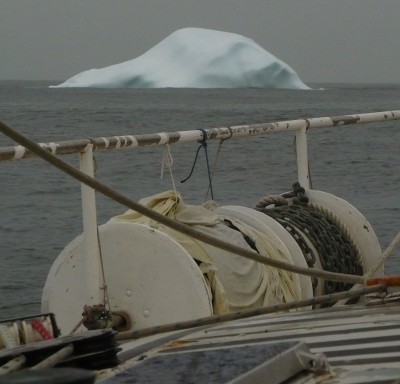 We left Black Tickle on a quiet morning, motoring out of the still harbor and away from the coast until the wind picked up enough to sail. The piece of ice in the photo was fairly close to the shore.I’d been paying a lot of attention to the weather forecasts. Computer programs made their guesses, the National Weather Service made their guesses, Environment Canada made their guesses, and I looked at all these and made my guesses. We were all wrong :). What was expected to be a brisk reaching wind turned into a mere slog dead to windward in F4-6 seas for a little over a day. We dodged several growlers and bergy bits in the intermittent rain and fog. The forecasts had now changed to be another day of headwinds to 30 knots. We were sailing against the south-flowing Labrador current, and progress was slow when, during a gybe, the inner jib (trinquette) refused to come across. A quick check up forward showed the stay was no longer attached to the mast. We got the other sails down so we would be heading downwind, and then brought the stay and sail (it was a roller-reefed sail) onto the deck. It seemed that the cotter pin that holds the clevis pin that holds the stay (wire) in place had sheared off. We got the sail off and cleaned up the deck, then changed course and sailed and motorsailed towards Cartwright, which was only about 130 miles back from where we were. As we got closer to the coast, the wind became quite favorable, the sun came out and we had a pleasant sail to within a few hundred metres of the dock. There we went to start the engine to motor onto the dock, and that began the John Deere Saga, which is the topic of another post.
We left Black Tickle on a quiet morning, motoring out of the still harbor and away from the coast until the wind picked up enough to sail. The piece of ice in the photo was fairly close to the shore.I’d been paying a lot of attention to the weather forecasts. Computer programs made their guesses, the National Weather Service made their guesses, Environment Canada made their guesses, and I looked at all these and made my guesses. We were all wrong :). What was expected to be a brisk reaching wind turned into a mere slog dead to windward in F4-6 seas for a little over a day. We dodged several growlers and bergy bits in the intermittent rain and fog. The forecasts had now changed to be another day of headwinds to 30 knots. We were sailing against the south-flowing Labrador current, and progress was slow when, during a gybe, the inner jib (trinquette) refused to come across. A quick check up forward showed the stay was no longer attached to the mast. We got the other sails down so we would be heading downwind, and then brought the stay and sail (it was a roller-reefed sail) onto the deck. It seemed that the cotter pin that holds the clevis pin that holds the stay (wire) in place had sheared off. We got the sail off and cleaned up the deck, then changed course and sailed and motorsailed towards Cartwright, which was only about 130 miles back from where we were. As we got closer to the coast, the wind became quite favorable, the sun came out and we had a pleasant sail to within a few hundred metres of the dock. There we went to start the engine to motor onto the dock, and that began the John Deere Saga, which is the topic of another post.
Black Tickle
Black Tickle, Labrador
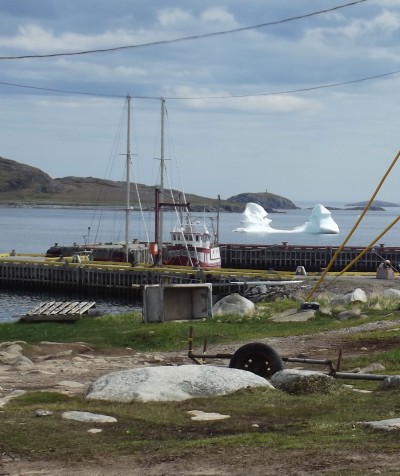 The harbor of Black Tickle. Issuma’s masts are visible to the left of the red fishing boat. A melting iceberg is in the background. We spent a pleasant day in Black Tickle, resting, looking around, talking to people, and refilling the airtime on the satellite phone (this actually took most of the day). Black Tickle has a population of about 200 people, a crab processing plant and several fishing boats that operate out of the harbor. There are no roads to the island Black Tickle is located on…the ferry comes weekly.From Black Tickle, we sailed north northeast.
The harbor of Black Tickle. Issuma’s masts are visible to the left of the red fishing boat. A melting iceberg is in the background. We spent a pleasant day in Black Tickle, resting, looking around, talking to people, and refilling the airtime on the satellite phone (this actually took most of the day). Black Tickle has a population of about 200 people, a crab processing plant and several fishing boats that operate out of the harbor. There are no roads to the island Black Tickle is located on…the ferry comes weekly.From Black Tickle, we sailed north northeast.
Morning
near Black Tickle, Labrador
